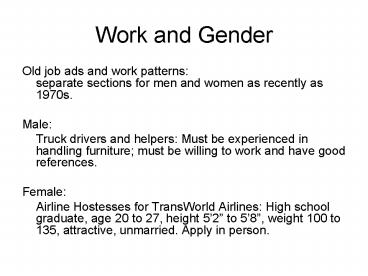Work and Gender - PowerPoint PPT Presentation
1 / 22
Title: Work and Gender
1
Work and Gender
- Old job ads and work patternsseparate sections
for men and women as recently as 1970s. - Male
- Truck drivers and helpers Must be experienced
in handling furniture must be willing to work
and have good references. - Female
- Airline Hostesses for TransWorld Airlines High
school graduate, age 20 to 27, height 52 to
58, weight 100 to 135, attractive, unmarried.
Apply in person.
2
Work and Gender
- Current patterns women and men work in different
jobs, for different pay, and are treated
differently. - Causes today are more subtle than old segregated
job ads, but they exist and matter for womens
(and mens) outcomes.
3
Work and Gender
- A broad definition of work is any activity that
produces a good or service. - Types of work
- Paid (market) work
- Unpaid (non-market) work
- Forced work
4
Work and Gender
- Defining sex and gender
- Sex a classification based on biological
differences - Gender a classification based on the socially
constructed differences overlaid on top of sex
5
Work and Gender
- The distinction between sex and gender is useful
- Biological differences create different sexes,
- Social and cultural differences create different
genders - There is little or no natural difference in
identity.
6
Work and Gender
- Gender categorization is a feature of interaction
that is nearly universal for us now. - Categorization is often accompanied by
stereotyped information. This can lead to
implicit bias although someone may not have
biased conscious opinions, they may retain
unconscious society-wide stereotypes and these
may shape their perceptions and beliefs.
7
Work and Gender
- Take the Implicit Bias Test
- https//implicit.harvard.edu/implicit/
- Please record your results to bring in next time.
8
Work and Gender
- Gender is also involved with how work is
structured explicitly in three ways - The sexual division of labor
- Devaluation of womens work
- The construction of gender at work
9
Work and Gender
- There is often a clear division between womens
work and mens work, called the gender division
of labor.
10
Gendered Occupations?
- Nurse Doctor
- Cashier Accountant
- Teacher Professor
- Truck Driver
- Secretary Manager
- Baker Chef
- Librarian Network Analyst
- Policeman, fireman, longshoreman, etc.
11
Work and Gender
- The sexual/gender division of labor varies over
time and across societies (see book for
examples). - However, the devaluation of womens work is
relatively constant womens work is nearly
always lower paid than mens work.
12
Work and Gender
- Devaluation is somewhat more difficult to prove
than the sexual division of labor. - Occupational earnings depend on many factors,
notably the complexity of the jobs, the strength
of the employees bargaining power, etc.
13
Work and Gender
- Gender construction at work comes from two main
sources employers and workers - 1. Employers may seek a particular gender
because of beliefs about the suitability of the
work, refuse to intervene, or attempt to use
gender differences to reinforce divisions between
workers
14
Work and Gender
- 2. Workers may recreate gender beliefs from
outside the workplace within the workplace. - For example, notions about whether someone is
man enough to do the job or notions about how
women are supposed to act will structure
interaction and help recreate gender roles within
the workplace. - Professional sports are a rather egregious
example of a work setting where gender plays an
overwhelming role.
15
Work and Gender
- Clear case that gender matters in relation to
work. - Where do these patterns come from? Employers,
workers, societal norms? - Reasonable to suggest that the system is,
overall, set up to put women in a subordinate
position?
16
- Variation across time and place matters
- Variation indicates that patterns are socially
determined - Understanding why variation occurs helps us
understand how to change situations - Past differences influence ways of thinking about
what is appropriate now
17
- Variation across time
- - prior to the Industrial Revolution, there was
less gender differentiation in work - - men and women would work together in fields or
on other household tasks - - women in many cases still played a subordinate
role, but closer than at some points later in time
18
- Variation across time
- 1850 to 1900 womens participation in work
falls, as a result of male workers and
employers actions and changes in ideas about the
appropriateness of womens labor force
participation - Introduction of protective labor laws
- Ideology of separate spheres
19
- Ideology of separate spheres
- Suggested that women and men belonged in
different spheres women in the home, while men
belonged in the world outside - Reinforced by Evangelical Christianity in the
United States and England.
20
- Ideology of separate spheres
- Rev. Henry Venn It is therefore nothing less
than an open resistance to the ordinance of God
in a wife to affect to rule, or to refuse to
submit to the authority of her husband. - Women were assumed to be more naturally
religious, justifying their position in the home
to pass this on to children
21
- Variation across time
- Womens labor force participation in the 20th
century increases every decade until now. Social
movement activity helped change attitudes and
abolish formal barriers. - Mens labor force participation simultaneously
declines, partially because of the increasing age
of men in the United States and an increase in
disabilities over time. - These two trends mean that mens and womens
labor force participation are now relatively
close.
22
(No Transcript)































